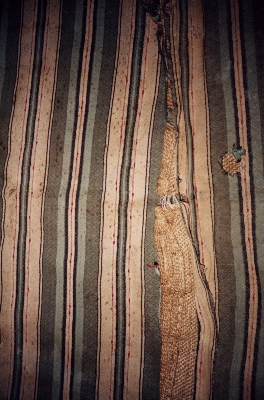Quilt No.375MR - Max Robertson

1950 x 1130mm
The Wagga Rug was made from 4 wheat bags by Norman Robertson and used on the beds in the family home at Coolamon. Max's daughter-in-law Mary purchased a new sewing machine in the mid 50s and decided to cover the Wagga Rug. She purchased striped cottage twill at Kelly and Cunningham in Wagga Wagga and put a wholecloth cover on it.
This Wagga Rug remains in the family, is valued and was used until about 1995.
Norman Robertson worked on properties in the Coolamon district of NSW and also at Pike's flour mill. One of his jobs was sewing up bags of wheat on farms. He made the Wagga Rug to use on beds in the sleepout of the Coolamon house where the family slept summer and winter.
Max, Norman's son, born 1933 worked unloading wheat trucks on a Saturday morning when he was a schoolboy. Max later used the Wagga Rug on his many motor bike trips around Victoria and usually carried it in another wheat bag. In 1960 when Max and Mary were married they took the Wagga Rug (now covered with the twill) in their panel van.
The family still has the old style bag needle that was used in making the Wagga rugs.
[Refer to the excellent photographs in 'Coolamon Through the Eye of the Camera' Max Robertson especially pages 90 and 91, wheat at the railway yards.]
Related Quilts:
1520 x 990 mm
2000 x 1820mm
1610 x 1610mm
1790 x 1160mm






